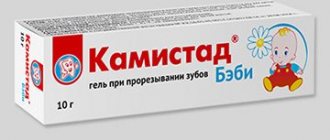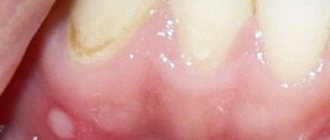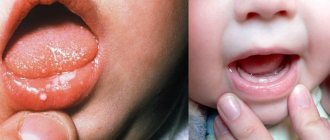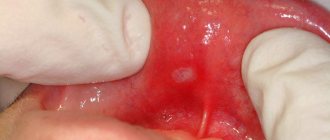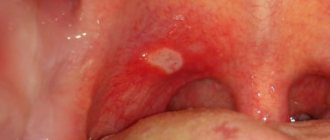Stomatitis is one of the most common dental diseases, which is expressed in damage to the oral mucosa. It occurs in both adults and children and requires urgent treatment. Treatment of stomatitis in children is usually required for children with weakened immune systems. There are many ways for infection to enter a small organism.
Urgently contact the dental department of the CELT clinic if your child exhibits the following symptoms:
- increased temperature;
- no appetite;
- a white coating appears on the gums;
- ulcers appeared in the mouth;
- lymph nodes hurt.
We have everything to carry out effective, prompt and painless treatment of stomatitis in children of any age. Bring to us children under one year old, 2-3 years old and older - and we will select effective treatment for him in each individual case.
Consultation with a pediatric dentist (pedodontist) - RUB 1,000.
Apexification with the application of a temporary filling (1 channel) - 1,500 rubles.
Filling the root canals of baby teeth - 4,000 rubles.
Installation of insulating gasket "VITRIBOND" - 800 rubles.
At CELT you can get advice from a dental specialist.
- Cost of consultation with a pediatric dentist (pedodontist) – 1,000
Make an appointment
Causes and types of stomatitis
Treatment of stomatitis in young children is carried out by treating the affected areas with special medicinal compounds, the choice of which is carried out in accordance with the etiology of the disease. Treatment is prescribed by the pediatric dentist after examining the small patient and identifying the cause and nature of the disease.
The disease can develop due to bacteria entering the mouth through dirty hands or cutlery, as well as due to a weakened immune system. The spread of pathogenic bacteria in a child’s body occurs at extreme speed due to the vulnerable mucous membrane. An additional factor is weak salivation, which causes a lack of hydration. Excessive dryness leads to cracks into which bacteria penetrate and cause disease.
Stomatitis often develops while taking pharmacological drugs. To avoid progression of the disease, you need to stop taking antibiotics. During the consultation, the decisive factor is the observations of the parents. They are the ones who can explain the cause of the disease (injury to the mucous membrane, allergies, taking antibiotics).
Aphthous stomatitis
Aphthous stomatitis is characterized by the appearance of a large number of aphthous stomatitis on the oral mucosa. These are round or oval ulcers covered with plaque. The causes of this disease are as follows:
- past infectious diseases: influenza, measles;
- lack of vitamin B12 and microelements in the body;
- oral injuries;
- gastrointestinal diseases.
For the most effective treatment of aphthous stomatitis in children, our specialists pay special attention to identifying the cause that caused it. Treatment of acute stomatitis in children is simply necessary, since the disease itself is very difficult. Its characteristic feature is unpleasant pain symptoms, which intensify when the ulcers are touched with hot or sweet food.
Treatment of purulent stomatitis in children requires an integrated approach. It consists not only in local treatment of ulcers with medications, but also in proper diet, frequent drinking and regular oral hygiene.
Gingitis, stomatitis
In the treatment of superficial inflammation of the mucous membrane, the choice of the appropriate medication is based on the color of the tissue, provided that the selected medication corresponds to the significant general symptoms.
For a fresh, bright red color, Belladonna is used.
Belladonna - acute onset of inflammation with bright red mucous membrane. The mucous membrane of the oral cavity is swollen, marked redness with dryness and burning, throbbing pain. The tongue is shiny, red (raspberry tongue). Desire to drink cold drinks in small sips, although they often increase the pain. With a pronounced disturbance in the general condition, sometimes with fever, the patient sweats, the face is hyperemic, the pupils are dilated, and pulsation of the carotid arteries is visible. The drug is indicated for acute stomatitis and gingivitis.
The dark red color of the mucous membrane corresponds to Phytolacca. Phytolacca - dark color and stabbing pain indicate progressive inflammation. Later, whitish pustules can be seen on the mucous membrane, which merge to form a plaque. Indicated for stomatitis with beginning suppuration and plaque. If the mucous membrane has a bluish-red color, the use of Lachesis and Carbo vegetabilis is justified.
Lachesis - purple-red color up to cyanosis is a sign of inflammation with stasis in the capillaries and breakdown of blood elements, which leads to ulceration. Oral pain worsens from warm drinks and food. Cold foods, especially ice, reduce pain. The general condition is sharply disturbed, sometimes there is a septic course, which is manifested by fear, anxiety and increased heart rate. Indicated for stomatitis, ulcerative stomatitis, and threatening septic conditions.
Carbo vegetabilis - bluish coloration of the inflamed mucous membrane with burning pain due to slow oxidation and oxygen deficiency in the tissues. Tendency to form ulcers; ulcers bleed easily; their bottom is bluish or gray. The tongue is coated with a dirty coating. Chilliness with cold body, but need for fresh air. Indicated for stomatitis, aphthous stomatitis, ulcerative stomatitis and ulcerative membranous stomatitis. For inflammation with tissue swelling, a preparation from bees is used.
Apis mellifica - the reaction to a bee sting is manifested by bright red swelling with glassy edema and burning, stabbing pain.
This phenomenon is consistent with the pathogenesis of Apis. The inflamed mucous membrane becomes pale red due to swelling. The pain is relieved by cold drinks and worsened by hot drinks. Thirst is often slight. The drug is indicated for stomatitis with tissue swelling. Share your interest!
Viral stomatitis
The name of viral stomatitis speaks for itself: it is caused by influenza, herpes, measles and chickenpox viruses.
Symptoms of the disease at an early stage include weakness, lethargy, a slight increase in body temperature, and pain in the mouth. When examining the oral cavity, you can see the appearance of small red ulcers on the mucous membrane and tongue. Treatment of viral stomatitis in children depends on the age of the child, the state of his immunity and the stage of the disease. As a rule, our experts recommend treating the oral mucosa with anti-inflammatory drugs and decoctions, and lubricating the affected areas with vitamin A.
Candidal stomatitis
Candidal stomatitis is known as thrush. It can appear in children even in infancy, and it is caused by saprophytic fungi, which become pathogenic when immunity decreases. With this type of stomatitis, white spots appear in the child’s mouth. In addition, there may be an occasional increase in temperature and the appearance of photophobia. Infection of a child can occur through contaminated dishes, toys or pacifiers.
Treatment of candidal stomatitis involves undergoing daily procedures in the dental office, rinsing the mouth with alkaline solutions, and taking vitamins.
Treatment of stomatitis in a child cannot be delayed, otherwise this may lead to relapse of the disease. CELT pediatric dentists recommend regular preventive examinations that will help prevent the development of serious dental diseases, including stomatitis!
Symptoms
Common symptoms of stomatitis are pain, burning, swelling of the mucous membrane and redness, and bad breath. Salivation also changes - it can be excessive or insufficient, with dry mouth. In some cases, there may be an increase in temperature and enlargement of the submandibular lymph nodes.
The types of stomatitis in children and treatment methods differ, as do the specific manifestations. For example, with aphthous stomatitis, only one large ulceration may appear, but with viral stomatitis, inflammation almost always takes the form of numerous elements or a rash merging into one focus.
Candidal stomatitis is characterized by the formation of a white or yellowish cheesy coating. It is easier to recognize traumatic stomatitis because it is preceded by damage or the source of injury is nearby - a chipped tooth or a rough filling.
Treatment of stomatitis in a child
The main rule is to immediately contact a specialist and not use any gels or ointments based on recommendations from the Internet. Each type of pathology is treated differently, so the dentist conducts a comprehensive examination. Additional consultation with an otolaryngologist or dermatologist is often required.
In complex therapy, proper oral care is prescribed and professional toothpaste is selected. Solutions and gels are required. If the form is viral, then antibiotics are used, and if it is allergic, then antihistamines are used. If necessary, medications are used to reduce the temperature (if there is fever and chills).
How to treat stomatitis
Whatever the form of stomatitis, treatment always begins with a visit to the dentist.
He makes a diagnosis and prescribes treatment. If necessary, you may need to consult other specialists, such as a gastroenterologist, immunologist or allergist. Depending on the form of stomatitis, the doctor examines the patient and listens to complaints or prescribes laboratory tests, for example, bacterial culture of a smear or skin scraping, as well as a PCR study to determine the causative agent (herpes virus, fungus, etc.). Treatment of stomatitis usually occurs with local remedies and includes:
- normalization and maintenance of high-quality oral hygiene
- spot treatment of ulcers with drugs with antimicrobial, antiviral or antifungal action
- pain relief with anesthetics
- reducing swelling and redness with anti-inflammatory drugs
In addition, part of the therapy is a special diet that will help reduce inflammation and will not irritate the mucous membrane.
Prevention of stomatitis in children
- Be sure to clean all cutlery, bottle and pacifier. Boil periodically.
- You need to brush your baby teeth 2 times a day. Cleaning should be carried out by parents up to 6 years of age, and then show all the movements to the child and teach him proper oral hygiene.
- After eating food, you need to rinse your mouth with boiled or filtered water that is well removed from bacteria.
- Wash your hands and all toys regularly. Children often put their fingers or toys in their mouths - wean them off this (many pathogenic bacteria get into the mucous membranes).
- Visit your dentist 2 times a year for a visual examination and disease prevention.
- Do not give your child too hot or cold food. Avoid hard, spicy, sour and very salty foods. This will lead to injury to the oral mucosa.
- Avoid foods that cause allergies.
- Provide a healthy diet rich in minerals and vitamins. It is advisable to walk outdoors more often. All this helps strengthen the immune system and protect against stomatitis.
Stomatitis: how to treat it?
What is stomatitis?
Stomatitis is an inflammation of the oral cavity, which is accompanied by the formation of small white ulcers on the mucous membrane, swelling, pain and general deterioration of the condition. It usually occurs in children, but adults are also susceptible to this disease.
What types are there?
Aphthous – Also known as ulcerative, is a single pale or yellow ulcer with a red outer ring or a cluster of such ulcers in the mouth, usually on the cheeks, tongue or inside the lip. The causes are diseases of the stomach, intestines, as well as weak immunity.
Cold sores – Caused by the herpes virus, these are fluid-filled sores that appear on or around the lips. They rarely form on the gums or roof of the mouth, mainly on the inside of the cheeks and lips. It is very important not to start treatment, as it often becomes a chronic condition. Herpes sores later become crusted with scabs and are usually accompanied by tingling, soreness or burning before true sores appear.
Allergic – Occurs due to individual intolerance to various allergens that cause hypersensitivity. It is also accompanied by the formation of ulcers in the mouth, lips, tongue and gums.
Catarrhal - The most common type, occurs due to poor oral hygiene, various injuries, and dental diseases. Very often, swelling of the palate and fever are added to the main symptoms.
Symptoms and where does it appear?
Stomatitis can be caused by a local infection, a systemic disease, a physical or chemical irritant, or an allergic reaction to various allergens.
It also very often appears due to poor oral hygiene and eating unwashed fruits and vegetables.
The main symptoms are:
- White sores in the mouth
- Blisters
- Facial peeling
- Swelling
- Oral dysesthesia (numbness)
- Burning mouth syndrome is painful despite normal appearance.
How to identify?
Despite the large number of types of stomatitis, it is very easy to treat, but the first thing you need to do is consult a dentist so that he can determine which type the patient has. This is achieved by various laboratory tests:
- Bacterial smears
- Viral swabs
- Tissue scrapings for mycology
- Biopsy for histology and direct immunofluorescence
- Blood tests
- Patch tests to identify contact allergies
Based on the results, an experienced specialist will select the right treatment and you will definitely end this disease.
How to cure?
Treatment of stomatitis depends on the cause and complexity of the disease.
These are mainly antibacterial/antiviral drugs, in combination with antiseptics. Sometimes doctors prescribe various gels and ointments, which contain anti-inflammatory and anesthetic substances, which must be applied directly to the infected area.
Also very common are rinses based on plants, such as chamomile, sage, calendula. They not only cope well with the disease, but are also an inexpensive substitute for other drugs.
Sources
"Stomatitis", World Medical Directory "The Merck Manuals",
https://www.msdmanuals.com/professional/dental-disorders/symptoms-of-dental-and-oral-disorders/stomatitis#v1145780
"Herpetic stomatitis", American National Library of Medicine
https://medlineplus.gov/ency/article/001383.htm
"Denture Stomatitis", Cleveland Clinic
https://my.clevelandclinic.org/health/diseases/21702-denture-stomatitis
How to care for a child after stomatitis appears?
Without the help of parents, a child will never get rid of the disease, because strict discipline is needed. You must follow all the requirements of the pediatric dentist and pay special attention to diet and pain medications.
Prefer soft food with a temperature of no more than 28o C. It is important that it has a balanced composition of carbohydrates, fats, proteins, vitamins, and minerals. Allergens, as well as spicy, sweet, sour and very salty foods, must be excluded from the diet. It is advisable to exclude citrus fruits due to their high acid content. After eating, rinse your mouth with filtered or boiled water.
Treatment includes the use of painkillers. The child will feel severe pain at first, which will interfere with sleep. Therefore, you need to regularly rinse your mouth not only with clean water, but also with medicinal balms. The affected area should be smeared with medicinal gel. All recommendations for treatment and pain relief will be given to you by your pediatric dentist during your consultation.
Make an appointment through the application or by calling +7 +7 We work every day:
- Monday—Friday: 8.00—20.00
- Saturday: 8.00–18.00
- Sunday is a day off
The nearest metro and MCC stations to the clinic:
- Highway of Enthusiasts or Perovo
- Partisan
- Enthusiast Highway
Driving directions

